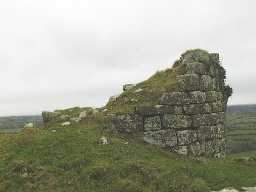|
The name Ardpatrick is from the Irish 'Ard Phádraig' meaning
the Height or Hill of Patrick, or the High Place of Pádraig. The
ancient name of the hill was 'Tulach na Feinne' which means the
hill of the Fianna. According to local tradition, the ruins on top of
the hill of Ardpatrick are those of a monastery founded by St Patrick
himself. The monastery of Ardpatrick was ruled by abbots drawn from the
Déisí, the ruling Sept of An Déis Bheag,
the territory in which the monastery was situated.
The parish of Ardpatrick was previously called Ballingaddy. Only recently
did the parish revert to the name of Ardpatrick. The name Ballingaddy
comes from Baile an Ghadaihe, the 'Town of the Thief'. The thief
was an Gadaihe Dubh Ua Dubháin, the 'Black Thief of O Duane'.
Ardpatrick was once part of the ancient parish of Kilquane, but has been
a parish in its own right since ancient times, although it was joined
with Kilfinane during penal times. In 1704 John Rahilly was registered
as parish priest of Kilfinane and Ardpatrick. In 1861 Ardpatrick was separated
from Kilfinane, and was formed as a separate parish. Rev. Thomas McIneiry
CC, Newcastle, was its first parish priest.
During the eleventh and twelfth centuries Ardpatrick monastery was at
its peak, being second in importance only to Armagh. Armagh had founded
a league of ecclesiastical centres, whose foundation was traditionally
ascribed to St Patrick, called Paruchia Patricii. Ardpatrick became
the chief centre of the Paruchia Patricii in Munster. On top of
Ardpatrick hill, the ruins can still be seen of a church, which probably
dates from the eleventh or twelfth century.

© Bell Tower at Ardpatrick
The remains can also be seen of what was presumably a residential
building. Outside the walls of the churchyard, the stump of a tower can
be seen. It was originally a round tower and later converted to a bell
tower. The bell tower was possibly older than the church, though most
of it had collapsed in a storm in 1824.
Five silver bells are said to have belonged to the monastery. Of these,
three were found in the ruins of the tower and were carried away by excavators.
Traces of a Holy Well are also to be seen outside the walls. On the 17th
of March and on the 15th of August there is a pilgrimage to the hill.
Mass is held on the hilltop on the last Sunday in August.
The slug of St Patrick's Cow's Horn, Leaba Rian Bó Phádraig,
is an ancient entrenched roadway near the church. Locals claim that the
stones at the entrance to the hill of Ardpatrick are the remains of what
was once a road from Armagh to Ardpatrick. The Abbot of Armagh used this
road to travel to Ardpatrick to collect his dues. During his time as Primate
of Armagh, Cardinal Tomás Ó Fiadh commemorated this tradition
by travelling to Ardpatrick where he met with Bishop Newman of Limerick
in 1980.
The area surrounding Ardpatrick is steeped in legend and myth. A townland
in Ardpatrick is called Glenosheen. The name is derived from Gleann
Oisín, meaning the Glen of Oisín. According to legend,
it was in this area that Oisín fell from his horse on his return
from Tír na nÓg, and was transformed instantly into an old
man.
The highest peak of the Ballyhouras is called Seefin, meaning Suí
Finn, Fionn's seat, in reference to Fionn Mac Cumhaill. Ardpatrick
hill was called Turlough na Fianna before the arrival of St Patrick.
In the mid eighteenth century, the local landlord Captain Oliver of Castleoliver,
had a small colony of Palatines settled in Glenosheen. There are still
a couple of Palatine families living in Glenosheen today.
Lord Colthurst of Blarney gave the land for the parochial house in 1888
to Canon Canty, on condition that rent of £2 per year was paid,
£1 to be paid in March and the second £1 to be paid in September.
 
|